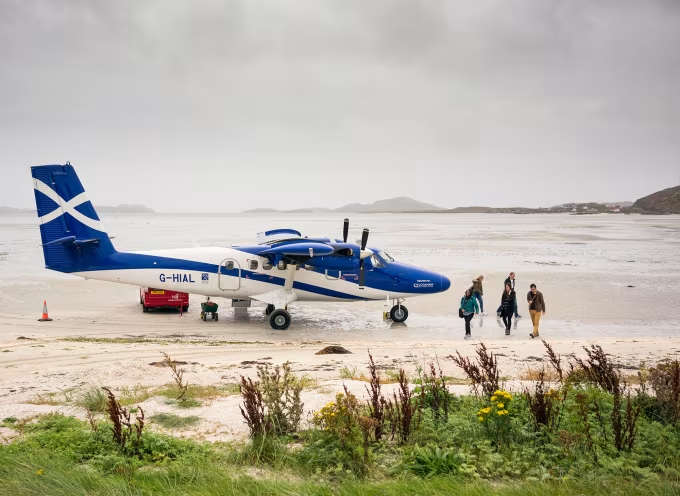Air travel usually calls to mind long, featureless strips of concrete. But around the world pilots and passengers encounter runways that read more like travel postcards — a beach that doubles as a landing strip, golf holes hemmed in by taxiways, cliff-edge minis and alpine slopes that demand special training. Here are some of the most spectacular — and surprising — places aircraft touch down.
Traigh Mhòr, Barra — the beach that’s also a runway
On the Isle of Barra in Scotland, the shoreline itself becomes the airport: scheduled flights use a tidal beach for takeoffs and landings, and operations are governed by the ebb and flow of the sea. Markers are moved with the tide, small Twin Otter aircraft are the norm, and when the windsock is down the public can stroll the sand where planes usually land.
Maho Beach, Princess Juliana International — landing feet from sunbathers
Few approaches are as famous (or as adrenaline-charged) as the low-altitude final into Princess Juliana International on Sint Maarten. Jets fly just above Maho Beach before touching down, offering plane-spotters a thrill — and a warning: powerful jet blasts have led to injuries, so local authorities post safety notices for visitors.
Juancho E. Yrausquin, Saba — the runway the size of a football field
Perched on rocky outcrops with the ocean at both ends, Saba’s Juancho E. Yrausquin Airport has the world’s shortest commercial runway — about 400 metres (1,312 ft). Landings here require pinpoint precision and small STOL aircraft; the airstrip’s sheer cliffs make it a bucket-list experience for thrill-seeking passengers and pilots.
Courchevel Altiport — a ski-resort runway with steep grade
At the Courchevel altiport in the French Alps, short length combines with a severe uphill gradient (almost 18–19%) and high elevation, creating one of Europe’s most technically demanding paved runways. The strip serves private and light aircraft bringing skiers straight to the slopes, but only specially qualified pilots routinely use it.
Don Mueang’s Kantarat Golf Course — fairways between runways
Bangkok’s Don Mueang airport contains a rare sight: an 18-hole golf course tucked between active runways. Players pass through security to reach the course and a red-light system halts play during landings; the unusual setup underlines how airports sometimes grow around city constraints and historic land uses.
Madeira (Funchal) — runway on stilts above the sea
Madeira’s airport extended its runway over the ocean on a platform supported by hundreds of giant pillars, turning a once-short, mountain-hemmed strip into an icon of engineering. The platform extension allowed larger jets to operate safely but also made Madeira famous for its dramatic approaches.
Gibraltar — road and runway intersect
At Gibraltar International Airport, a major road used to cross the runway itself; traffic was routinely stopped by barriers whenever planes landed or took off. (Recent works have added a tunnel to ease vehicle flow, but the runway’s unusual relationship with the town remains notable.)
Why these odd runways persist
Most of these unusual strips exist because geography, history and demand collide: islands with no flat land, alpine resorts built on mountaintops, dense urban areas where airports squeezed into leftover parcels, or military-era layouts that remain in civilian use. They also spotlight aviation’s adaptability — special pilot training, bespoke operating procedures and engineering creativity keep these runways safe and functional despite their quirks.
For travellers they’re part cautionary tale, part attraction: a reminder that the world still contains real edges and angles that machines and people must carefully negotiate. Whether you prefer sunbathers watching widebodies or a mountain approach that feels like a roller-coaster, these runways deliver the kind of arrival you’ll likely never forget.










